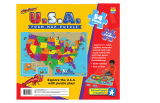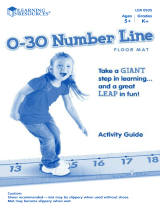Page is loading ...

EI-3063
Grades K+
Ages 5+

2
GETTING STARTED
Depending on the age and experience of your students, have them do the
following activities:
• Placethecoinsonthemagneticwhiteboard.Helpthestudentsidentifyeach
coin.Havethemnoticetheircolorandsize.(Ask:Whatcoloriseachcoin?
Whichcoinisthesmallest?Whichcoinisthelargest?)
• Havestudentsstatethevalueofeachcoin(e.g.penny=1cent,nickel=5cents,
dime=10cents,quarter=25cents,andhalf-dollar=50cents).
penny nickel dime quarter half-dollar
10pennies
10nickels
10dimes
5quarters
2half-dollars
5$1bills
2$5bills
2$10bills
2$20bills
1$50bill
1$100bill
Activityguide
Contents:
INTRODUCTION
The Big Money Magnetic Coins and Bills set is designed to teach students the
following:
•coinandbillidentification
•coinandbillvalues
•coinandbillequivalences
•addingandsubtractingmoney
•makingchange
•fractions,decimals,andplacevaluewithmoney
•problem-solvingskills
Big Money Magnetic Coins and Billscanbeusedonanymagneticsurface,such
asmagneticwhiteboardsandfilingcabinets.Thesetcanalsobeusedonflat
surfacessuchastablesanddesks.Eachofthe50super-realisticmoneypiecesis
correctly formed with accurate detailing to help students identify real coins and
bills.Oversizedforeasy-viewingfromanywhereintheclassroom,theBig Money
Magnetic Coins and Bills set is perfect for small and large group instruction, as
wellasforcentersandindependentlearning.

3
• Showstudentsthatmoneyamountscanbewrittenusingthecentsign(¢)andthe
dollarsign($).Forexample,thevalueofapennycanbewrittenas1¢or$.01.
Explainthatthecentsignindicatesthenumberofcentswhilethedollarsign
indicatesthenumberofdollars.Onepennyisworth1centorofadollar,two
penniesareworth2centsorofadollar,etc.(Youmaywishtoshowyour
students that
=$.02=2cents.Usethisasanintroductiontotheterms
fraction and decimal.)Thenputsomecoinsonthemagneticboardandhave
studentspracticewritingtheamountsusingthecentsignandthedollarsign.
one dollar bill five dollar bill ten dollar bill
twenty dollar bill fifty dollar bill one hundred dollar bill
CLASSROOM ACTIVITIES
Teaching Money with the Date
Startingonthefirstdayofschool,andeverydaythereafter,placeapennyon
theboard(underthedate)torepresentanotherdayofschool.Whenfivedays
ofschoolhavepassed,replacethefivepennieswithanickel.Afteronehundred
daysofschool,youshouldhaveadollarbillontheboard.Thisisagreatwayto
quicklyreviewmoneyconceptseverydayoftheschoolyear.
Tuesday, 9/8/09 (First day
of school)
Monday, 9/14/09
Wednesday, 9/9/09 Tuesday, 9/15/09
Thursday, 9/10 /09 Monday, 10/12/09 (25 days)
Friday, 9/11 /09 Wednesday, 11/10/09 (46 days)
Examples of
“Money Dates”
100
2
100
2
100
1
• Placethebillsonthemagneticwhiteboardandaskstudentstoidentify
eachone.
• Havestudentsstatethevalueofeachbill.(Forexample,theonedollarbill
equals1dollaror100cents.)

4
Identify the Pattern and the Coin
Putapatternofmagneticcoinsontheboard(e.g.penny,nickel,penny,nickel,
etc.).Leaveablankspace(ordrawaline)inplaceofoneofthecoins.Ask
studentstoidentifythemissingcoin.Then,askastudenttocomeuptothe
board,findthecorrectcoin,andplaceitinthepattern.
For example:
10¢
10¢
10¢
10¢
Show Money in Order of Value
Displayavarietyofcoinsinrandomorder.Askstudentstoarrangethecoinsin
leasttogreatestorderaccordingtotheirvalue(e.g.penny,nickel,dime,quarter,
half-dollar).Repeattheactivitywithbills.
Sort and Count Coins
Displaycoinsonamagneticsurface.Askstudentstosortthecoinsintogroups
ofpennies,nickels,dimes,andquarters.Havestudentsskipcounttodetermine
thevalueofeachgroupofcoins.(Forexample,ifthereare5nickels,students
mightsay,“5,10,15,20,25.That’s25cents!”)
How Many Different Ways?
Challengestudentstoshowthevalueofacoinordollarbillinasmanywaysas
possibleusingothercoinsandbills.
For example:

More, Less, Equal?
Displaytwogroupsofcoinsonthemagneticwhiteboard.Usingadry-erasepen,
have students place a >, <, or =signbetweenthem.
For example:
5
Showing Equivalent Value
Placeagroupofcoinsonthemagneticwhiteboard.Totherightofthisgroup,
placethreemoregroupsofcoins,makingsurethatatleastonegroupisequal
tothegroupontheleft.Instructstudentstofindthegroup(s)ontherightthat
areequivalenttotheoneontheleft.Haveastudentcomeuptotheboardand
circletheequivalentgroup(s),usingadry-erasemarker.
For example:
>
=

6
Reducing a Group Down to One
Placevariousrowsofcoinsonamagneticwhiteboard.(Selectgroupsofcoins
thatwilladduptoanamountthatcanberepresentedbyonecoin.)Students
should determine the value of each row using one coin to represent its total
value.Repeatthisactivityusingbills.
For example:
=
Coin Group +
/
– Coin Group = Answer
1penny + 4pennies = 1nickel
1nickel + 5pennies = 1dime
1dime – 1nickel = 1nickel
4nickels + 3dimes = 1half-dollar
1dime – 1nickel,4pennies = 1penny
1penny,1nickel – 5pennies = 1penny
1half-dollar – 1quarter = 1quarter
1half-dollar – 4dimes = 1dime
1dime + 2nickels = 2dimes
1quarter,2dimes + 2quarters,1nickel = 2half-dollars
2pennies + 2nickels = 1dime,2pennies
1quarter – 2nickels = 1dime,1nickel
1half-dollar – 10pennies,2nickels = 1quarter,1nickel
3dimes – 1nickel,2pennies = 2dimes,3pennies
Adding and Subtracting Coins
Placeanycombinationofcoingroupsonamagneticwhiteboard.Usingadry-
erasepen,writeanaddition(orsubtraction)signbetweenthetwogroups,
followedbyanequalssign.Askstudentstoadd(orsubtract)thefollowing
groupsofcoins,showingtheanswersusingthefewestcoinspossible.

7
Counting Money
Displaygroupsofcoins,groupsofbills,orgroupsofcoinsandbillsona
magneticsurfaceorflattable.Havestudentswritethetotalvalueforeach
grouponasheetofpaperoronthewhiteboard.Note:Askstudentstowork
with mixed groupings only after they have mastered the groupings of coins and
billsseparately.Makesurestudentsunderstandthattheyshouldbegincounting
withthecoinorbillofthegreatestvalueandendwiththecoinofleastvalue.
For example:
Alternatively,youcanputupagroupofcoinswithanequalssignandthe
answer,butleaveoutoneofthecoins.Thestudentsmustidentifythemissing
coin.Intheexampleabove,youmightleaveoutthenickel.Oncestudentshave
identifiedthemissingcoin,askastudenttocomeuptotheboardandadda
nickeltothecoingroup.
Showing Cash Value
Bringinrealproducts(toys,householditems,groceries,etc.)ormagazine
picturesandhavestudentslabeleachwithaprice.Instructstudentstoshowthe
valueusingcoinsoracombinationofcoinsandbills.
For example:
= 27¢

8
Making Change
Createaclass“grocerystore”usingmagazineclippings,coupons,orrealfood
productsfromhome.Labeleachitemwithaprice.Dividethestudentssothat
somearestoreemployeesandothersaregroceryshoppers.Askthe“shoppers”
tousethecoinsandbillstopayfortheproducts,andhavethe“employees”
givethemthecorrectchange.Thenhavestudentsswitchroles.
For example:
PAID:$2.00 CHANGE: 65¢
Estimating Price
Displayagroupofcoinsandbillsonamagneticwhiteboard.Then,placethree
photosofobjectsnexttothemoney.Studentsshouldidentifytheitemthat
wouldmostlikelyhavethatprice.Forexample:putahalf-dollar,aquarter,two
dimes,andthreepenniesontheboard.Ontheright,showapictureofahouse,
acandybar,andapairofshoes.Studentsshouldbeabletoidentifythecandy
barasthemostlikelytohavethedisplayedpriceof$.98.
For example:
HOW MUCH?

9
Place Value
Drawaplacevaluechartonthemagneticwhiteboard.Includehundreds,tens,
ones,tenths,andhundredthscolumns.Placebillsandcoinsintheirrespective
columns.Then,havestudentsrecordthemoneyvaluesontheirpaper.Discuss
thenumbersineachcolumnwithyourstudents.Forexample,thepenniesarein
thehundredthscolumnbecausethey’reofadollar.Repeatwithdifferent
monetaryvalues.Insomecases,leaveonecolumnblankinthemiddle(e.g.no
dimes:$2.08)sostudentscanseethatzeroplace-holdersareused.
For example:
$111.41
PLACE VALUE CHART
$100.00 $10.00 $1.00 $.10 $.01
Alternatively,writethemonetaryamountonthewhiteboardandaskastudent
toselectthecorrectcoinsandbillsandplacethemintheirrespectiveplacevalue
columnstoequalthatamount.
The following Piggy Bank Puzzles are great logical thinking activities that build
on students’ money knowledge.
Piggy Bank Puzzle I
Drawapictureofapiggybankontheboardorbringinarealone.Thengive
students the following clues:
• Therearethreecoinsinthepiggybank.
• Oneofthecoinsistwicethevalueoftheother.
• Thecoinsaddto40cents
Whatarethecoins?(answer:nickel,dime,quarter)
Havestudentssolvetheproblemandthenaskavolunteertodisplaythe
corresponding(magnetic)moneyontheboard.Theremaybemorethanone
answer, in which case students may display multiple magnetic coin groupings on
theboard.Continuetheactivitywithotherquestionsandclues.
100
1

Piggy Bank Puzzle II
Drawblanksonthemagneticwhiteboard.LabelthemA, B, C, D, and E.Nextto
eachblank,placethemagneticcoinsandbillsasshowninthepicturebelow.
Then,writethefollowingproblemwithcluesontheboardandhavestudents
solvethepuzzlebyfillinginthecorrectnameontheblanknexttothemagnetic
currency.Herearetheproblemandclues:
Jenny,Ernesto,Kwan,LaShondra,andDarrelhavepiggybanks.Readtheclues.
Writeeachnamenexttothecorrectcollectionofmoneyinthatchild’sbank.
1.Jennyhas3quartersand1dime.
2.Ernestohas70centslessthanJenny.
3.Kwanhastheequivalentof6quarters.
4.ErnestoandJennytogetherhavethesameamountasDarrel.
5.HowmuchmoneydoesLaShondrahave?
10
Money in their piggy banks
A.
B.
C.
D.
E.
(Answers:A=Kwan,B=Darrel,C=LaShondra,D=Jenny,andE=Ernesto)
Makeupadditionalproblemsforyourstudents,adjustingthedifficultylevelas
needed.Forfun,useyourstudents’names!

11
EXTENSION ACTIVITIES
Herearesomemoneyactivitiesacrossthecurriculum.
Social Studies
• ShowamapoftheworldandaskwhereAmericanmoneyisregularlyused.
StudentsshouldknowthatthesamemoneyisusedineveryU.S.stateaswell
asU.S.territories,suchasPuertoRico,AmericanSamoa,andGuam.
• DiscusstheU.S.MintanditsfunctionintheproductionofU.S.coinsaswellas
TheBureauofEngravingandPrintingwhichmakesourpaperbills.Show
studentspictures,brochures,orvideosortakethemonarealtourorvirtual
visit(seewww.usmint.gov and www.moneyfactory.gov for more
information).
• Researchsomeofthepeopleandsymbolsshownonourmoney,suchas
GeorgeWashington,BenjaminFranklin,orthephraseE Pluribus Unum.
• Havestudentsbringinforeigncurrency.Discusswhichcountriesthemoney
camefromandcomparetheirvaluestothoseofourbills.
Art
Havestudentstracetheoutlineofthecoinsandbillsontopaperaspatternsfor
designingtheirowncurrency.Whatvalueswouldtheircoinsandbillshave?
Whosefacewouldtheyputonthemoney?Theycanevenbringinphotosof
themselves,theirfamily,ortheirpetstoputonthebills!
Language Arts
• Makealistofothernamesforcoinsstudentshaveheard(e.g.change,cents,
piece).
• Discussandlistothernamesforpapermoney(e.g.bills,dollars,cash,notes,
currency).Forfun,talkabouttheslangtermsformoney;someexamples
mightinclude:dough,moolah,greenbacks,bucks,bread,greenstuff,dinero.
DineroistheSpanishwordformoneyandisagreatwaytoconnectwith
EnglishLanguageLearnerswhosefirstlanguageisSpanish.
• Explaintostudentsthattheword‘quarter’referstothefactthatthiscoinis
one-quarter(
)ofadollar.Ahalfdollarisone-half(
)ofadollar.Show
studentsthat‘threequartersofadollar’meansofof1andcanbe
representedwith3quarters.
• Askstudentstolistwordscontainingtheprefixorroot“cent.”Some
examples might include: century, percent, centipede, centennial, centimeter,
andcentigrade.Pointoutthatallofthesewordshavesomethingtodowith
thenumberonehundred.Discussthemeaningofcentas
and its origin
fromtheLatincentum,meaning“100.”Ask,“Whatdoesadollarhavetodo
withonehundred?”(It’sonehundredcents!)
4
1
2
1
4
3
100
1

Check out these other great money teaching materials:
EI-3149 PrestoChange-O
EI-3059 CoinsandBillsDeluxePlayMoneySet
EI-2762 HotDotsMoneyFlashCards
Developed in Southern California by Educational Insights.
© Educational Insights, Inc., Gardena, CA (U.S.A.). All rights reserved. Learning
Resources Ltd., King’s Lynn, Norfolk (U.K.). Please retain this information.
Made in China.
www.Educational
Insights.com
/

















